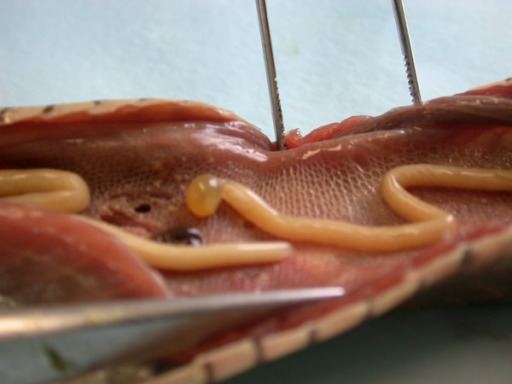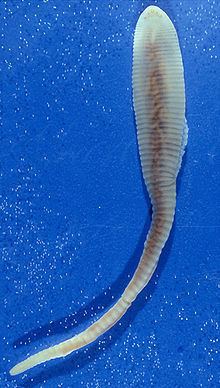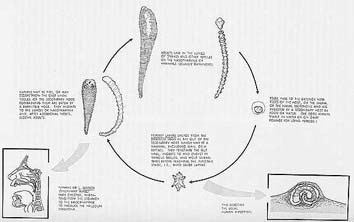Scientific name Pentastomida | Subphylum Crustacea Rank Subclass | |
 | ||
Similar Linguatula serrata, Arthropod, Crustacean, Porocephalus crotali, Branchiura | ||
Pentastomida are an enigmatic group of parasitic crustaceans commonly known as tongue worms due to the resemblance of the species of the genus Linguatula to a vertebrate tongue.
Contents
- Biology
- Anatomy
- Life cycle
- Human infestation
- Affinities
- Crustaceans
- Stem arthropods
- Fossil record
- Classification
- References

There are about 130 extant species of pentastomids; all are obligate parasites with correspondingly degenerate anatomy. Adult tongue worms vary from about 1 to 14 centimetres (0.4 to 5.5 in) in length, and parasitise the respiratory tracts of vertebrates. They have five anterior appendages. One is the mouth; the others are two pairs of hooks which they use to attach to the host. This arrangement led to their scientific name, meaning "five openings", but although the appendages are similar in some species, only one is a mouth.

Alternative names for the Pentastomida include Pentastoma (strictly a genus name), Linguatulida, and Acanthotheca.
Biology

Historically significant accounts of tongue worm biology and systematics include early work by Josef Aloys Frölich, Alexander von Humboldt, Karl Asmund Rudolphi, Karl Moriz Diesing and Rudolph Leuckart.

Other important summaries have been published by Louis Westenra Sambon, Richard Heymons and John Riley, and a review of their evolutionary relationships with a bibliography up to 1969 was published by J. T. Self.
Anatomy
Pentastomids are worm-like animals ranging from 2 to 13 centimetres (0.79 to 5.12 in) in length. The anterior end of the body bears five protuberances, four of which are clawed legs, while the fifth bears the mouth. The body is segmented and covered in a chitinous cuticle. The digestive tract is simple and tubular, since the animal feeds entirely on blood, although the mouth is somewhat modified as a muscular pump.
The nervous system is similar to that of other arthropods, including a ventral nerve cord with ganglia in each segment. Although the body contains a haemocoel, there are no circulatory, respiratory, or excretory organs.
Life cycle
Pentastomids live in the upper respiratory tract of reptiles, birds, and mammals, where they lay eggs. They are gonochoric (having 2 sexes), and employ internal fertilisation. The eggs are either coughed out by the host or leave the host body through the digestive system. The eggs are then ingested by an intermediate host, which is commonly either a fish or a small herbivorous mammal.
The larva hatches in the intermediate host and breaks through the wall of the intestine. It then forms a cyst in the intermediate host'S body. The larva is initially rounded in form, with four or six short legs, but moults several times to achieve the adult form. The pentastomid reaches the main host when the intermediate host is eaten by the main host, and crawls into the respiratory tract from the oesophagus.
Human infestation
Tongue worms occasionally parasitise humans. While there is a report of Sebekia inducing dermatitis, the two genera responsible for most internal human infestation are Linguatula and Armillifer. Visceral pentastomiasis can be caused by Linguatula serrata, Armillifer armillatus, Armillifer moniliformis, Armillifer grandis, and Porocephalus crotali.
The terms associated with infections can vary:
Porocephalus and Armillifer (which are all cylindrical and all inhabit snakes) have much more in common with each other than they do with Linguatula (which is flat and inhabits dogs and wolves.)
Affinities
The affinities of tongue worms have long proved controversial. Historically, they were initially compared to various groups of parasitic worms. Once the arthropod-like nature of their cuticle was recognised, similarities were drawn with mites, particularly gall mites (Eriophyidae). Although gall mites are much smaller than tongue worms they also have a long, segmented body and only two pairs of legs. Later work drew comparisons with millipedes and centipedes (Myriapoda), with velvet worms (Onychophora) and water bears (Tardigrada). Some authors interpreted tongue worms as essentially intermediate between annelids and arthropods, while others suggested that they deserved a phylum of their own. Tongue worms grow by moulting, which suggests they belong to Ecdysozoa, while other work has identified the arthropod-like nature of their larvae, In general, there are two current alternative interpretations: pentastomids are highly modified and parasitic crustaceans, probably related to fish lice, or they are an ancient group of stem-arthropods, close to the origins of Arthropoda.
Crustaceans
The possibility that tongue worms are crustaceans can be traced back to the work of Pierre-Joseph Van Beneden, who compared them to parasitic copepods. The modern form of this hypothesis dates from Karl Georg Wingstrand's study of sperm morphology, which recognised similarities in sperm structure between tongue worms and fish lice (Argulidae) – a group of maxillipod crustaceans which live as parasites on fish and occasionally amphibians. John Riley and colleagues also offered a detailed justification for the inclusion of the tongue worms among the crustaceans. The fish louse model received significant further support from the molecular work of Lawrence G. Abele and colleagues. A number of subsequent molecular phylogenies have corroborated these results, and the name Ichthyostraca has been proposed for a (Pentastomida + Branchiura) clade. Thus a number of important standard works and databases on crustaceans now include the pentastomids as members of this group.
Stem-arthropods
Critics of the Ichthyostraca hypothesis have pointed out that even parasitic crustaceans can still be recognised as crustaceans based on their larvae; but that tongue worms and their larvae do not express typical characters for Crustacea or even Euarthropoda. An alternative model notes the extremely ancient Cambrian origins of these animals and interprets tongue worms as stem-group arthropods. A recent morphological analysis recovered Pentastomida outside the arthropods, as sister group to a clade including nematodes, priapulids and similar ecdysozoan 'worm' groups. Adding fossils, they suggested an extinct animal called Facivermis could be closely related to tongue worms. However it should be stressed that these authors did not explicitly test pentastomid/crustacean relationships.
Fossil record
Exceptionally preserved, three-dimensional and phosphatised fossils from the Upper Cambrian Orsten of Sweden and the Cambrian/Ordovician boundary of Canada have been identified as pentastomids. Four fossil genera have been identified so far: Aengapentastomum, Bockelericambria, Haffnericambria and Heymonsicambria. These fossils suggest that pentastomids evolved very early and raise questions about whether these animals were parasites at this time, and if so, on which hosts. Conodonts have sometimes been mentioned as possible hosts in this context.
Classification
This article follows Martin and Davis in placing Pentastomida in the class Maxillopoda within the subphylum Crustacea. The subclass contains the following extant orders, superfamilies, families, genera and species:
